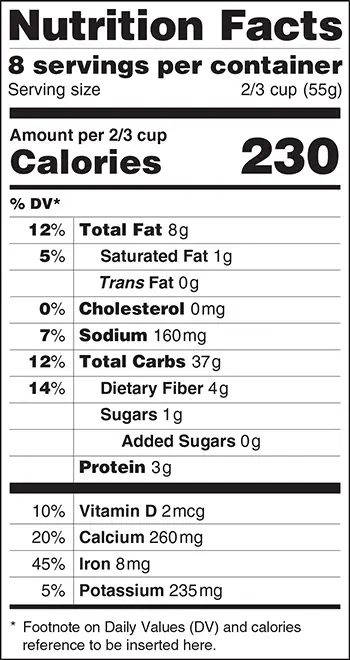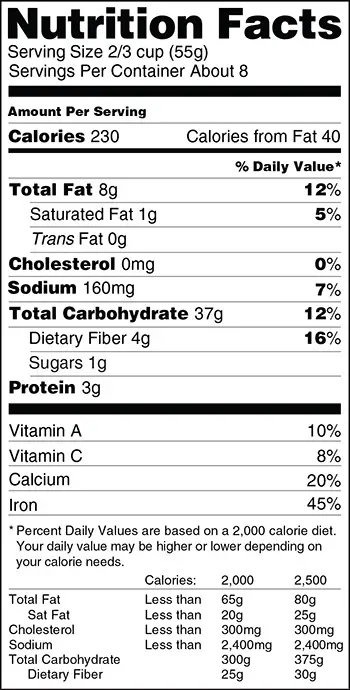Translate this page to any language by choosing a language in the box below.
The FDA's Proposed New Food Labels: Sugar Content is Added, Emphasis on Calories and Portions
The FDA's Proposed New Food Labels: Sugar Content is Added, Emphasis on Calories and Portions
FDA's New Packaged Food Label Adds Focus to Sugar, Calories, and a Larger Font
The US FDA (Food and Drug Administration) announced on February 27, 2014 a
proposed revised new food label for packaged foods. The FDA proposed to would
include more information about sugar content, caloric content, and replace
out-of-date serving sizes to better align with how much people really eat,
and it would feature a new design to highlight key parts of the label
such as calories and serving sizes.
First Lady Michelle Obama said "Our guiding principle here is very
simple: that you as a parent and a consumer should be able to walk into your
local grocery store, pick up an item off the shelf, and be able to tell whether
it's good for your family. So this is a big
deal, and it's going to make a big difference for families all across this
country."
The Nutrition Facts label has been required on food packages for
20 years, helping consumers better understand the nutritional value of foods so
they can make healthy choices for themselves and their families. The label has
not changed significantly since 2006 when information on trans fat had to be
declared on the label, prompting manufacturers to reduce partially hydrogenated
oils, the main source of trans fat, in many of their products.
Highlights of the proposed changes to the food label
The Proposed NEW food label

- Require information about the amount of "added
sugars" in a food product. The 2010 Dietary Guidelines for Americans states that
intake of added sugar is too high in the U.S. population and should be reduced.
The FDA proposes to include "added sugars" on the label to help consumers know
how much sugar has been added to the product.
- Update serving size
requirements to reflect the amounts people currently eat. We all
know that the current sizes are absurd. Look at any can of soup,
for example. One tiny can is supposedly 2.5 servings. Most people
eat the entire contents of the can. What and how much
people eat and drink has changed since the serving sizes were first put in place
in 1994. By law, serving sizes must be based on what people actually eat, not on
what people "should" be eating. Present calorie and nutrition information for
the whole package of certain food products that could be consumed in one
sitting.
- Show information as both per serving AND per package -
The proposed label has two columns to indicate both "per serving" and "per
package" calorie and nutrition information for larger packages that could be
consumed in one sitting or multiple sittings.
- Include
potassium and vitamin D information, which are nutrients that some in the U.S. population are not
getting enough of, which puts them at higher risk for chronic disease. Vitamin D
is important for its role in bone health. Potassium is beneficial in lowering
blood pressure. Vitamins A and C would no longer be required on the label,
though manufacturers could declare them voluntarily.
- Revise the Daily Values
for a variety of nutrients such as sodium, dietary fiber and Vitamin D. Daily
Values are used to calculate the Percent Daily Value on the label, which helps
consumers understand the nutrition information in the context of a total daily
diet.
- "Calories from Fat" would be removed because
research shows the type of fat is more important than the amount. The
labels would continue to require "Total Fat," "Saturated Fat," and
"Trans Fat" data.
- Rearrange the layout to
emphasize certain elements, such as calories, serving sizes and Percent Daily
Value, which are important in addressing current public health problems like
obesity and heart disease.
Notice how large the calorie and serving size information is in the
proposed label.
- Smaller label: Nutrition Facts Label Proposed Format
(350x660) compared with the current size, (350x690)
Why did the FDA propose these changes to the food label?
The FDA says "By revamping the Nutrition Facts
label, FDA wants to make it easier than ever for consumers to make better
informed food choices that will support a healthy diet." said Michael R. Taylor,
the FDA's deputy commissioner for foods and veterinary medicine. "To help
address obesity, one of the most important public health problems facing our
country, the proposed label would drive attention to calories and serving
sizes."
Which labels are affected?
The changes proposed today affect all packaged foods except certain meat,
poultry and processed egg products, which are regulated by the U.S. Department
of Agriculture's Food Safety and Inspection Service.
The FDA is also
proposing to make corresponding updates to the Supplement Facts label on dietary
supplements where applicable.
Additional information
The agency is accepting public comment on
the proposed changes for 90 days.
-
US FDA Press release
For more information:
Media
Inquiries: Theresa Eisenman, 301-796-2805,
[email protected].
Consumers Inquiries: 888-INFO-FDA
Federal
Register notice
The CURRENT food label

-
USA Today - Proposed food labels stress calories, sugar, portions
Kim Painter, Special for USA TODAY 12:39 a.m. EST February 27, 2014
The FDA and first lady announce the first new nutrition labels in two
decades.
"The listing of added sugars will help consumers sort out
which sugar comes from the peaches in their canned peaches and which
comes from sweeteners, Jacobson says. The same goes, he says, for foods
such as sweetened yogurt, where some sugar comes from milk and fruit but
a lot comes from added sugar."
-
CNN Health - Nutrition labels getting a makeover
By Jacque Wilson
and Jen Christensen, CNN
updated 6:52 AM EST, Thu February 27, 2014
"Chemically, added sugar is the same, but studies show many Americans
eat more sugar than they realize. The American Heart Association
recommends you limit added sugar to no more than half your daily
discretionary calories. That means for American men, about 150 calories
a day, or nine teaspoons. For women it's a smaller amount -- no more
than 100 calories per day from added sugar, or about six teaspoons of
sugar.
A USDA study released last month showed 42% of working-age
adults between 29 and 68 looked at these labels most or all of the time
when shopping. Some 57% of Americans older than 68 did as well. That's
up from 2007, when 34% of working-age adults looked at the label, and
51% of Americans older than 68 did."
-
New York Times - New F.D.A. Nutrition Labels Would Make 'serving Sizes' Reflect Actual Servings
By SABRINA TAVERNISEFEB. 27, 2014
"Twenty-ounce bottles of soda would be counted as one serving, rather
than the 2.5 servings often listed now. And the serving size listed on
cartons of ice cream, currently a half-cup, would be increased to one
cup.
"Half a cup of ice cream is absurd," Professor Nestle said.
"Unless you go to a really fancy restaurant, you're lucky to come out
under two cups."
Other public health officials were skeptical,
arguing that too few Americans use nutrition labels for the changes to
make much of a difference. Others argued that restaurants, which are a
major source of calories for Americans and have increased portion sizes
substantially, are the biggest offenders.
"This is a false victory,"
said Barry M. Popkin, a health researcher at the University of
North Carolina at Chapel Hill..."
-
ABC News - New Food Labels Would Highlight Calories and Sugar
WASHINGTON February 27, 2014 (AP)
By MARY CLARE JALONICK Associated Press
Excerpt:
"Calories would
be in larger, bolder type, and consumers for the first time would know
whether foods have added sugars under label changes being proposed by
the Obama administration. Serving sizes would be updated to make them
more realistic. A serving of ice cream, for example, would double to a
full cup, closer to what people actually eat."
-
CBS News - Nutrition fact label changes proposed by FDA
ByRYAN
JASLOWCBS NEWSFebruary 27, 2014, 12:01 AM
"Vitamin D and potassium
will make appearances on the nutrition facts for the first time,
replacing vitamins A and C. That's because vitamin D and potassium are
two nutrients that some Americans are not getting enough of, according
to the FDA, when they play important roles in benefiting bone health and
blood pressure, respectively. Calcium and iron will remain, and
manufacturers can choose to put in vitamins A and C if they wish."
-
Center for Science in the Public Interest - Bring Food Labeling into the 21st Century!
This
illustration shows some of the ways in which food labels could be
improved (click to view larger version)
:
Links to US FDA pages and regulations
Related Information
Wheat Gluten Allergies Gluten-Free Labeling of Foods
An estimated 3 million people in the United States have celiac disease.
In people with celiac disease, foods that contain gluten trigger production
of antibodies that attack and damage the lining of the small intestine. Such
damage limits the ability of celiac disease patients to absorb nutrients and
puts them at risk of other very serious health problems, including
nutritional deficiencies, osteoporosis, growth retardation, infertility,
miscarriages, short stature, and intestinal cancers.
-
On August 2, 2013, FDA issued a final rule defining "gluten-free" for food
labeling, which will help consumers, especially those living with celiac
disease, be confident that items labeled "gluten-free" meet a defined standard
for gluten content.

